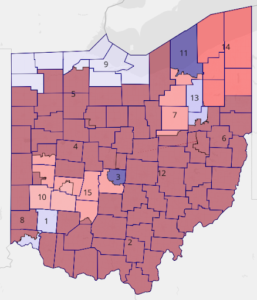Blog
Tagged In: democracy, fair maps, redistricting
The State of Redistricting [March, 2022]
Chris Tavenor, General Counsel, March 15, 2022
For the latest updates on our fight for fair maps, please click here.
It’s March 2022, and Ohio still does not have fair district maps—for its congressional map or for its statehouse map.
At the Ohio Environmental Council, we hold strong in our commitment to a healthy democracy. Only with a healthy democracy can we ensure a healthy environment.
Here’s the problem: certain Republican leaders only want to ensure a rigged redistricting process. The five Republican members of the Ohio Redistricting Commission have continually voted for maps biased toward their own party. Instead of upholding the will of Ohioans, who voted overwhelmingly to end partisan gerrymandering in 2015 and 2018, these politicians have decided to cheat.
They’re trying to rig maps to silence the vote of millions of Republican, Democrat, and Independent Ohio voters. Gerrymandering only benefits partisan and special interests. It encourages extremist supermajority actions in the statehouse and discourages meaningful compromise on issues all Ohioans support, like climate action, investments in renewable energy and safe drinking water, and more.
Where have we been in the fight for fair maps? Check out our timeline here: https://theoec.org/campaigns/redistricting2021/
Where are the Ohio Supreme Court cases heading? Below, we’re giving you the most up-to-date information about the state of redistricting in Ohio.
The fight for Ohio’s General Assembly Map continues at the Ohio Supreme Court
The OEC joined the Ohio Organizing Collaborative, the Council on American-Islamic Relations (CAIR-Ohio), as well as individual voters and community leaders (Ahmad Aboukar, Crystal Bryant, Samuel Gresham Jr., Prentiss Haney, Mikayla Lee, and Pierrette “Petee” Talley) in a lawsuit appealing the unfair state legislative map in September. Represented by the nationally-acclaimed Brennan Center for Justice at NYU Law and the law firm Reed Smith, we argued that the maps violated the prohibition against partisan gerrymandering and voters’ equal protection under the Ohio constitution.
Our fight for fair General Assembly maps finds its basis in the Article XI, Section 6 of the Ohio Constitution:
The Ohio redistricting commission shall attempt to draw a general assembly district plan that meets all of the following standards:
- No general assembly district plan shall be drawn primarily to favor or disfavor a political party.
- The statewide proportion of districts whose voters, based on statewide state and federal partisan general election results during the last ten years, favor each political party shall correspond closely to the statewide preferences of the voters of Ohio.
- General assembly districts shall be compact.
On February 28, in response to the third set of state legislative maps approved on party lines by the Ohio Redistricting Commission, we filed objections with the Supreme Court of Ohio. We argued that the new maps, like their predecessors, violate the Ohio Constitution’s prohibitions against partisan gerrymandering.
We asked the court to declare the most recent maps, adopted by the commission on February 24, invalid. Then, we urged the court to take up the district plan submitted to the General Assembly by Professor Jonathan Rodden. That map has district lines that meet constitutional standards. Thus, we asked the court to declare the Rodden plan valid and order the commission to state whether it will enact the Rodden plan and, if not, why it refuses to do so.
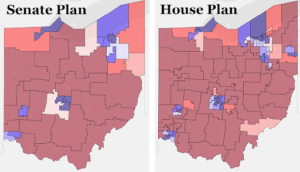 (The House and Senate plan developed by Jonathan Rodden, Ohio Supreme Court / Dave’s Redistricting App)
(The House and Senate plan developed by Jonathan Rodden, Ohio Supreme Court / Dave’s Redistricting App)
Why is the most recent General Assembly District Plan unconstitutional?
First, the commission created its new plan primarily to favor Republicans and disfavor Democrats, in violation of the Ohio constitution, and that the commissioners did so by identifying districts that leaned Republican and then adjusted the district lines just enough to create districts that lean Democratic by an extremely small margin.
Additionally, the commission’s maps aren’t proportionate to Ohio voter preferences.
The latest House map contains 54 districts that favor Republicans, 26 districts that favor Democrats, and 19 toss-up districts that both parties have an equal shot of winning. This means Republicans have more than double the number of favorable districts than Democrats. A small shift in voter preference toward the GOP would give the party nearly 75 percent of House seats. The Senate map shows similar manipulation and imbalance.
The most recent set of maps were invalidated on March 16, 2022 by a bipartisan majority of the Ohio Supreme Court. The Commission must propose a new map by March 28.
The Congressional District Plan: Also bad for Ohioans and our environment
In addition to our advocacy for fair state legislative maps, the OEC filed an amicus brief in support of the plaintiffs in the case appealing the unfair congressional map in December. Our brief illustrated the environmental injustices perpetuated through gerrymandered maps.
Our fight for fair Congressional maps finds its basis in the Article XIX, Section 1 of the Ohio Constitution:
(3) If the general assembly passes a congressional district plan under division (C)(1) of this section by a simple majority of the members of each house of the general assembly, and not by the vote described in division (C)(2) of this section, all of the following shall apply:
(a) The general assembly shall not pass a plan that unduly favors or disfavors a political party or its incumbents.
(b) The general assembly shall not unduly split governmental units, giving preference to keeping whole, in the order named, counties, then townships and municipal corporations.
In January, the Court struck down that first map, ruling it an unconstitutional gerrymander violating Article XIX of the Ohio Constitution. The Justices said:
When the dealer stacks the deck in advance, the house usually wins. That perhaps explains how a party that generally musters no more than 55 percent of the statewide popular vote is positioned to reliably win anywhere from 75 percent to 80 percent of the seats in the Ohio congressional delegation. By any rational measure, that skewed result just does not add up. (¶ 100, Regina C. Adams, et al. v. Governor Mike DeWine, et al.)
The Ohio General Assembly had a whole month (most of January and February) to propose a new map, but they took no action. That left the job to the Ohio Redistricting Commission, the same commission consistently gerrymandering statehouse maps.
The Ohio Redistricting Commission continued to cheat Ohioans by passing another gerrymandered map on March 2, 2022. The map ensures the following:
- 10 safe Republican seats
- 2 safe Democratic seats
- 3 competitive seats, all leaning Democratic
What does this mean? At most, Democrats—who have won 46% of Ohioans’ vote in the last decade—could occupy just 33% of our seats in Congress. But the Republicans—who have won just 54% of Ohioans’ vote in the last decade—unfairly drew themselves between ~70-90% of our seats.
The fight continues at the Ohio Supreme Court for the congressional maps, too. The OEC won’t be filing an amicus brief this time around—Court procedural timelines make it difficult to do so—but we support the efforts of the organizations already objecting to the bad congressional maps. The Court should rule within the next few weeks.
The gerrymandered congressional map passed by the Ohio Redistricting Commission, March 2, 2022. (Dave’s Redistricting App)
So where does the environment fit in?
The OEC engaged in the fight for fair maps because all Ohioans, regardless of political affiliation, deserve representation. Ohioans deserve districts that connect similar communities. They deserve compact districts. They deserve districts that make sense.
And without a fair and truly representative democracy, Ohioans will continue to face environmental injustices from big polluters. Check out our work featured by the Brennan Center for Justice, Yale Climate Connections, and Inside Climate News on this very topic:
 |
 |
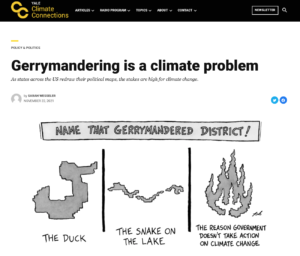 |
When gerrymandering occurs for partisan interests, it often results in other impacts to communities, too, dividing them in haphazard ways along strange lines.
District 1 in this map is likely the best example. In our amicus brief opposing the first congressional plan passed last year, we noted how District 1 divides communities in the Cincinnati area most impacted by environmental hazards:
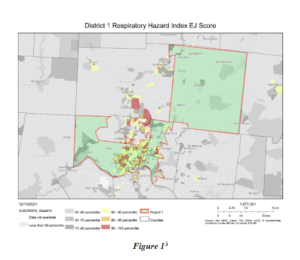 The new District 1 doesn’t solve this problem. Communities in northern Hamilton County are still excluded from District 1, a District that could easily fit within all of Hamilton County, rather than including Warren County to the northeast. And while the new District 1 is a Democratic-leaning competitive district, rather than a Republican district as it was in the first plan, the Commission intentionally chose not to include the entire district within Hamilton County so as to make it competitive.
The new District 1 doesn’t solve this problem. Communities in northern Hamilton County are still excluded from District 1, a District that could easily fit within all of Hamilton County, rather than including Warren County to the northeast. And while the new District 1 is a Democratic-leaning competitive district, rather than a Republican district as it was in the first plan, the Commission intentionally chose not to include the entire district within Hamilton County so as to make it competitive.
If the district were entirely contained within Hamilton County, keeping many similar communities together, it would not be a district the Republicans could possibly “flip” to acquire almost 90% of Ohio’s congressional delegation. The intention in drawing District 1 was still to favor partisan interests. And at the same time, it cracked apart communities who deserve a representative in Congress who will fight for environmental justice.
But we know a fair alternative is possible. Throughout 2021, the OEC supported the efforts of the Ohio Citizens’ Redistricting Commission, which proposed the congressional district plan seen below. It creates a map that matches Ohio’s partisan balance: seven districts lean Democrat, while eight districts lean Republican. Four of the Democrat districts are competitive, while two of the Republican districts are competitive.
And the map’s districts remain relatively compact, keeping communities together. For example, look at how District 1 stays entirely within Hamilton County, keeping those similar communities with one representative.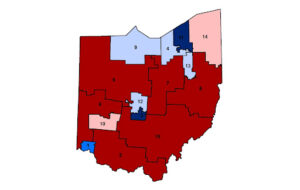
For more information about the Ohio Citizens’ Redistricting Commission (OCRC), visit: https://ohredistrict.org.
The existence of maps like the OCRC’s map illustrate the partisan bias of the congressional map most recently passed by the Ohio Redistricting Commission. The Republican members of the Commission are trying to ignore the language of the Ohio Constitution and cheat Ohio voters out of fair representation.
When partisan interests hijack the redistricting process, everyone loses, no matter their political beliefs. Ohioans deserve fair maps, both in Columbus and in Washington. When we have fair representation, we can fight back against extremist policies. We can fight for issues all Ohioans support, like clean water and renewable energy.
All Ohioans deserve a healthy democracy, ensuring their voices are heard from Cincinnati to Cleveland, from the Ohio River to Lake Erie, from Portsmouth to Lorain. Through a healthy democracy, we can collectively fight for a healthy environment for all Ohioans.
